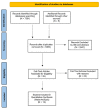A Systematic Review and Meta-Analysis of the Association between the FV H1299R Variant and the Risk of Recurrent Pregnancy Loss
- PMID: 36358309
- PMCID: PMC9687207
- DOI: 10.3390/biology11111608
A Systematic Review and Meta-Analysis of the Association between the FV H1299R Variant and the Risk of Recurrent Pregnancy Loss
Abstract
This study evaluated the association between the H1299R factor V (FV) variant (rs1800595) and recurrent pregnancy loss (RPL). Pubmed (MEDLINE) and Embase (OVID) bibliographic databases were searched from the inception to 31 May 2022 to identify suitable articles according to PRISMA and MOOSE guidelines. We included observational studies, case-control studies, cross-sectional studies, and cohort studies reporting a numerical and well-distinguished Het or Hom status of the H1299R variant obtained through PCR or other biochemical techniques and comparing RPL patients with a healthy control group. The review protocol was registered at PROSPERO (CRD42022330077). Two authors independently screened studies, extracted data, and carried out the risk of bias assessment using the Newcastle Ottawa scale (NOS). A meta-analysis was performed with RevMan software Version 5.4 using an odds ratio (OR) with an M-H, random effect, and 95% CI. We included 13 clinical studies for a total of 1669 RPL patients and 1466 healthy women as a control group. H1299R variant was slightly associated with RPL albeit without significance (OR 1.18, 95% CI: 0.78-1.80, p = 0.44). Subgroup analyses considering H1299R in heterozygosity (OR 1.13, 95% CI: 0.76-1.67, p = 0.56) and in homozygosity (OR: 2.11, 95% CI: 0.74-6.01, p = 0.16) revealed a similar trend. Lastly, we evaluated the association between H1299R and RPL based on the number of previous miscarriages (≥2 or ≥3). This comprehensive systematic review and meta-analysis sheds light on the specific influence of the H1299R variant in the F5 gene on RPL, constituting valid support for medical care during pregnancy and genetic counseling.
Keywords: H1299R; factor V (FV); miscarriages; recurrent pregnancy loss (RPL); thrombophilia; thrombophilic gene variants.
Conflict of interest statement
The authors declare no conflict of interest.
Figures







References
-
- Grandone E., Tiscia G.L., Mastroianno M., Larciprete G., Kovac M., Tamborini Permunian E., Lojacono A., Barcellona D., Bitsadze V., Khizroeva J., et al. Findings from a multicentre, observational study on reproductive outcomes in women with unexplained recurrent pregnancy loss: The OTTILIA registry. Hum. Reprod. 2021;36:2083–2090. doi: 10.1093/humrep/deab153. - DOI - PubMed
Publication types
LinkOut - more resources
Full Text Sources
Miscellaneous

